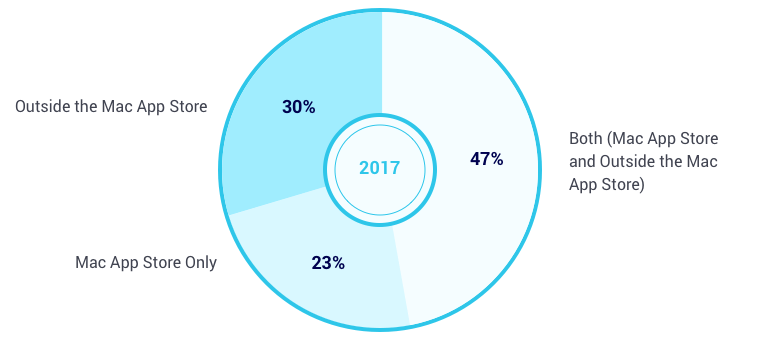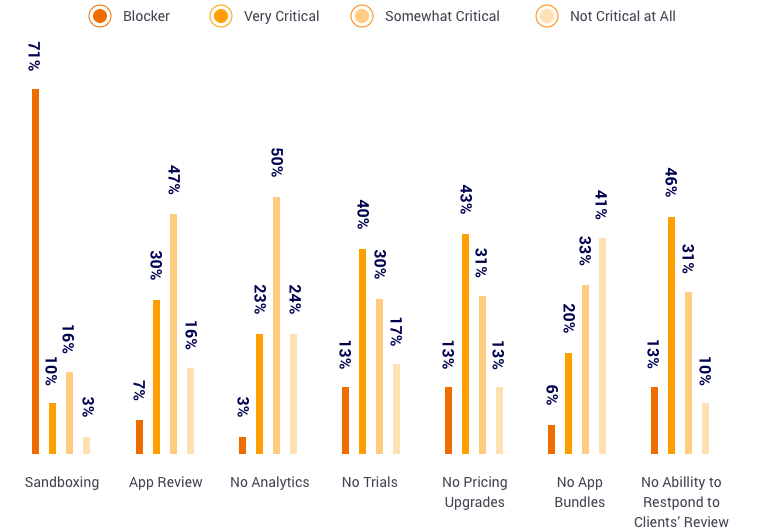One of Apple's golden egg hens, the App Store (from iOS), was launched in 2008. It was so successful that it spurred Ma to launch it also for Macs. Thus, in 2011, it was officially launched Mac App Store (MAS).
The app stores are always very secure as there is a very strict curation and facilitate both the distribution and the dissemination of the apps. On iOS, it is understandable that the adoption was massive, since it is not possible (without tricks) to install apps distributed in another way. In MAS, the scenario is different. Because it makes it possible to install applications even outside the store and probably for some other reasons that developers are well aware of, the Mac store is not so chime like this.
In a survey conducted by Setapp yes, that application subscription service, data was collected from more than 700 developers both last year and this year, in order to create a comparison and, from it, it will be possible to reach some conclusions regarding MAS.

In terms of distribution, the survey showed that most developers (42% in 2016 and 47% in 2017) prefer to make their software available both on MAS and outside it. Those who make it available only outside the store represented 35% in 2016 and 30% in 2017; maintaining a single (and worse) result, developers who distribute apps only through MAS accounted for 23% over the two years.
It is clear that, although there are some benefits in distributing the software by MAS, developers profit more when they make it available outside the store, since they do not have to pay the 30% to Apple. Therefore, regarding income, about 44% comes from MAS (48% last year), while 56% (52% in 2016) comes from outside the store.
Another issue analyzed in the survey was the possibility of recommending MAS as the main channel for distributing apps and, peculiarly, the results showed a favoring the store.

Although making the app available outside the store seems to be an advantage financially speaking, the satisfaction of this method is not so great. On the scale of 100 (everyone recommends) to -100 (no one recommends), distribution via MAS only got -34 this year (down from -23 in 2016), being recommended by 18% of developers. The distribution only outside the store was -97 (0% of recommendations) and those that distribute in both had -48 (increase from -54 last year).
In a more direct question for all developers, it was asked whether the "comfort" that MAS brings is worth the 30% charged. The result was 69% saying it is not worth it, which shows that the resistance continues to increase, since last year there were 62% of developers.
Despite this, it's not just the money that keeps developers from opting only for the macOS app store. Other issues were identified and showed that they are real annoyances for those who want to distribute their apps there: lack of data analysis, sandboxing, trial period, app packages (bundles), respond to evaluations, among others. At least one point is the last one developers can celebrate, as this is one of the improvements of iOS 10.3 and macOS Sierra 10.12.4.

Apple values security in its stores, primarily to benefit its users. However, by only allowing store apps to access system resources and data that users really need, something that bothers developers (71% dissatisfaction) who would need more than that to use the sandboxing.
According to the developers' rating of “excellent” to “terrible”, Apple still needs to improve on several other issues such as app approval time, communication with the approval team and clarity on the points that led to a particular app to be rejected. In general, the entire process received a reasonable 20% of “very good”.
The subscription model, recently implemented, was something that developers liked. About 48% stated that this improvement had positive impacts and 80% of those who tried it would recommend this way of distribution.
In addition to all this data, the survey basically showed that 76% of software developers for macOS have not yet tried to distribute them through MAS. When asked about the reason for this, 66% stated that it would be due to the long and “uncertain” way of approving applications; another 59% said the reason was the 30% required by Ma.
Although Apple may have its eyes much more focused on iGadgets, macOS still has a lot of potential to be explored in terms of app stores. We hope that the company will not delay in improving the Mac App Store so that it is advantageous for both users and developers.
via Cult of Mac
